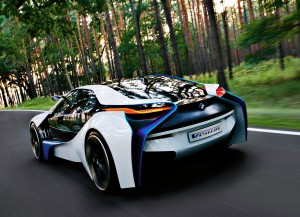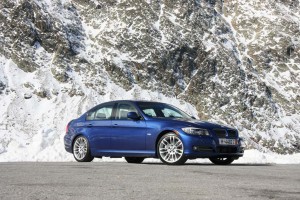
From hybrids to hydrogen vehicles - and possibly with diesel-hybrids, like this Vision Concept - BMW promises to go green, but can the maker hold down costs – and maintain the distinctive ride and performance that justifies its hefty product premium?
BMW has an alternative Vision of the future.
No, the Vision show car making its debut at the 2009 Frankfurt Motor Show, this month, won’t be rolling into showrooms anytime soon. Its diesel-hybrid powertrain is far too complicated and expensive to produce – for now. But Vision concept underscores the automaker’s increasingly energetic search for cleaner, high-mileage technology that can supplement, potentially even replace, the traditional powertrains that it has long relied on.
But “going green” poses some potentially serious challenges for the company, officials acknowledge. For one thing, while new laws may require – and consumers demand – cleaner, more fuel-efficient vehicles, the German maker must maintain the distinctive performance and ride that allows it to charge a premium for vehicles ranging from the subcompact 1-Series to its big 7-er sedans.
There’s also the issue of cost. Despite the traditional premium consumers have paid for the marque’s “spinner” logo, BMW officials question how much more motorists will shell out for “clean” vehicles.
The automaker’s push for alternative power is happening on a variety of technical fronts, notes Tom Baloga, engineering chief for BMW of North America. Its first gasoline-electric hybrid, the X6, is getting ready for launch, and will be followed, soon after by a hybrid version of the big 7-Series.
Using gas-electric technology in these large, lower-mileage models will have a much more significant impact, Baloga tells TheDetroitBureau.com, than introducing a hybrid version of what is already the relatively fuel-efficient 3-Series.
BMW’s first hybrids will be the product of an unusual joint venture that paired the German marque with General Motors, Chrysler and Daimler AG. That consortium, he explains, is now winding down, though it “has not officially come to a close.” The challenge of working in a four-way consortium, said Baloga is that everything “is a compromise.” Going forward, BMW will focus on hybrid technology that puts an emphasis on performance, even if that means sacrificing a bit of potential fuel economy.
The Vision concept suggests one potential direction. It pairs a turbocharged 3-cylinder diesel with a pair of electric motors to produce a hefty 356 horsepower and 590 pound-feet of torque – enough to launch the prototype from 0 to 60 in just 4.8 seconds.
Unfortunately, cautions Baloga, Vision pairs two of the most expensive technologies, diesel and hybrid, and the costs simply can’t be justified, at least not now. But don’t be surprised to see that small diesel show up on its own, company executives suggest, in the not-too-distant future.
Like its rival German makers, BMW is a big proponent of diesel power, something of an uphill fight when it comes to the U.S. market, its largest. Hybrids, contends Jim O’Donnell, CEO of the automaker’s American subsidiary, are “overrated,” even if they will be “part of the mix.”
So far, BMW has introduced two American diesel models: versions of the X5 Sport Activity Vehicle and the 3-Series sedan. Demand has been solid, the chief executive asserts, though he believes it could be ramped up a couple notches. For one thing, O’Donnell hopes to convince the BMW board to approve a new version of the 3-Series that would combine diesel and all-wheel-drive, which he believes would expand appeal in the Northeast and other parts of the Snowbelt.
Meanwhile, O’Donnell concedes that the diesel price premium needs be reduce to “less than $2,000,” rather than the current $4,000 added to the sticker of the X5 oil-burner. (Click here for the complete story.)
Neither executive believes the U.S. market – nor BMW in particular – will ever match Europe, where diesels control about half the new vehicle market. Traditional American resistance to the technology is one reason, but there’s a more practical reality, as well.
“People underestimate what you can squeeze out of the internal combustion engine,” O’Donnell tells TheDetroitBureau.com, using any number of advanced technologies, such as direct injection, that have been showing up on BMW’s EfficientDynamics concept and production vehicles. The alternator on the European version of the little 1-Series, for example, spins freely, when not needed, to reduce frictional losses.
Turbocharging is likely to become far more important, adds Baloga, “to get the mileage of a V-8 out of a six, the mileage of a 6 out of an I-4, and the fuel economy of a diesel out of a gasoline engine.”
Pushing for better mileage will be a particular demand for BMW, and its import luxury brethren, considering the size, weight and performance associated with their products. They’ve been giving some breathing room from the Obama Administration, which has approved a 3-year waiver from the new 35.5 mpg standard for 25% of the vehicles sold by lower-volume manufacturers. (The waiver impacts not only European luxury marques but weaker Asian brands, such as Mitsubishi.)
O’Donnell defends the controversial decision, insisting the market will eventually benefit from the additional technologies BMW brings to market to bring models like the 7-Series and X5 into compliance.
Eventually, the carmaker’s response could include various forms of “electrification,” says Baloga, from conventional hybrids to hydrogen-powered models using fuel cells or hydrogen-based internal combustion engines.
And then there are battery cars. BMW’s British Mini division is ramping up a test program using electric vehicles, dubbed the Mini E. Battery costs, weight and range are the most obvious challenges, according to Baloga, but there are other issues.
In urban centers, such as New York, he points out, many potential owners don’t have access to a garage where a vehicle like the Mini E could charge up. The automaker has begun a project with the Big Apple’s biggest garage operator, Central Parking, to fit its lots with high-speed chargers.
One way or the other, BMW says its products will feature very different drivetrain technology in the years ahead. But while meeting cost targets will be tough, the real challenge, concludes O’Donnell, will be to ensure that those future products maintain the “heritage” feel that distinguishes BMW vehicles from everyone else.

